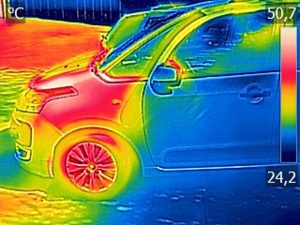We live in a day and age where new technologies are being brought to the market at what seems like lightening speed. One advancement leads to another, and then another. New products, based on emerging technologies are continuously being launched. One such technological advance is long-wave infrared – LWIR – imaging, also known as thermal imaging.
The technology doesn’t quite allow you to ‘see through’ walls, but, it’s about as close as one can get to x-ray vision. Recently, advances in detector fabrication and lower costs have made LWIR imaging more accessible for the industrial markets.
Infrared imaging technology was introduced at the first half of the 20th century. Since its inception, it is possible to recognize three generations of infrared cameras. The first-generation cameras were characterized by a single element detector, combined with two scanning mirrors to create infrared images. Their main disadvantage was that they suffered from saturation problems. The second-generation cameras were characterized by an increase in the number of detectors, positioned in a large linear array or in two small 2-D array.
The third-generation cameras, the ones currently being used, have increased the reliability and sensitivity of infrared systems. The main innovations characterizing modern cameras are the increased number of pixels, the higher thermal sensitivity, and the increased acquisition frequency.
LWIR detectors do not see scattered and reflected visible light; they are mainly responsive to infrared heat emitted from objects themselves. One way to experience this deep infrared light is with the outdoor heaters found on many terraces or the red heat lamps that keep trays of food warm in a restaurant. They heat skin (or food) by emitting a large quantity of infrared radiation.
An LWIR sensor can indicate where and in what quantity heat radiation is emitted. This offers two distinct advantages: The scene becomes independent of lighting conditions and the sensor is able to easily identify any type of heat-generating body. This last advantage has long made LWIR sensing a critical enabling technology for modern warfare.
Radiometric applications of LWIR imaging can be a great asset for industries such as food and material transformation because it offers the capability to measure, from a distance and without physical contact, the temperature of any shaped object at random locations. This allows for greater coverage in process control, as well as yield loss reduction. A chicken nugget factory, for example, might want to validate the temperature of all of its products when coming out of the oven. With a properly calibrated camera, all that is required for accurate measurements is to input information about the target object’s surface finish (emissivity) and the ambient conditions (humidity and temperature).
Another application rising to the forefront of LWIR imaging is in the automobile sector. BMW, one of the major automobile manufacturers in the world, decided that it would implement a thermal imaging camera for driver vision enhancement into their top-of-the-line 7-series. Increasing passenger and driver safety is one of the priorities for BMW. Since a lot of accidents happen during nocturnal driving, BMW was looking for a solution to reduce this number of accidents.
At Ford Motor Company, their engineers are currently using thermal imaging technology to recognize where air escapes from a vehicle. Using LWIR imaging, allows Ford to test multiple ways of how they can contain air within the vehicle. This is helpful to the design and developments of new vehicles to help reduce and prevent air leaks, reduce noise and develop heating and cooling systems that work more efficiently.
Whether through direct observation of heat distribution, indirect observation of heat movement, or through absolute temperature measurements, thermal imaging is bound to take a bigger place in the automation, inspection, and medical fields in the near future.
Universe Optics will work with you to design and manufacture a precision lens to meet the needs of the specific camera incorporating LWIR into your system.